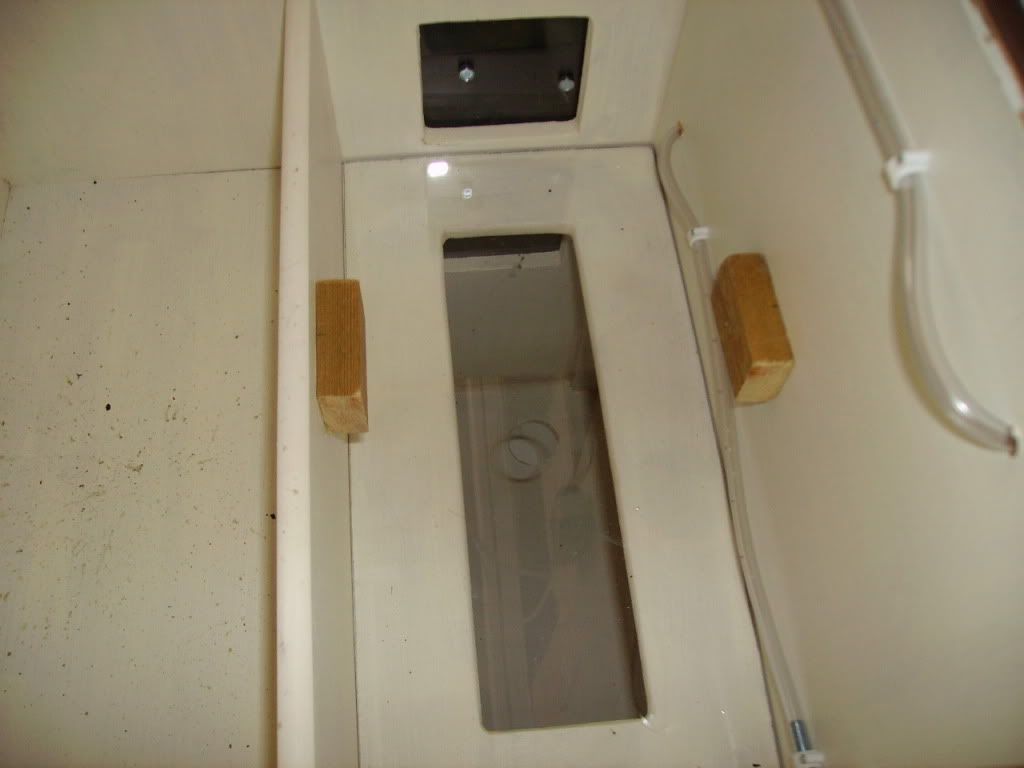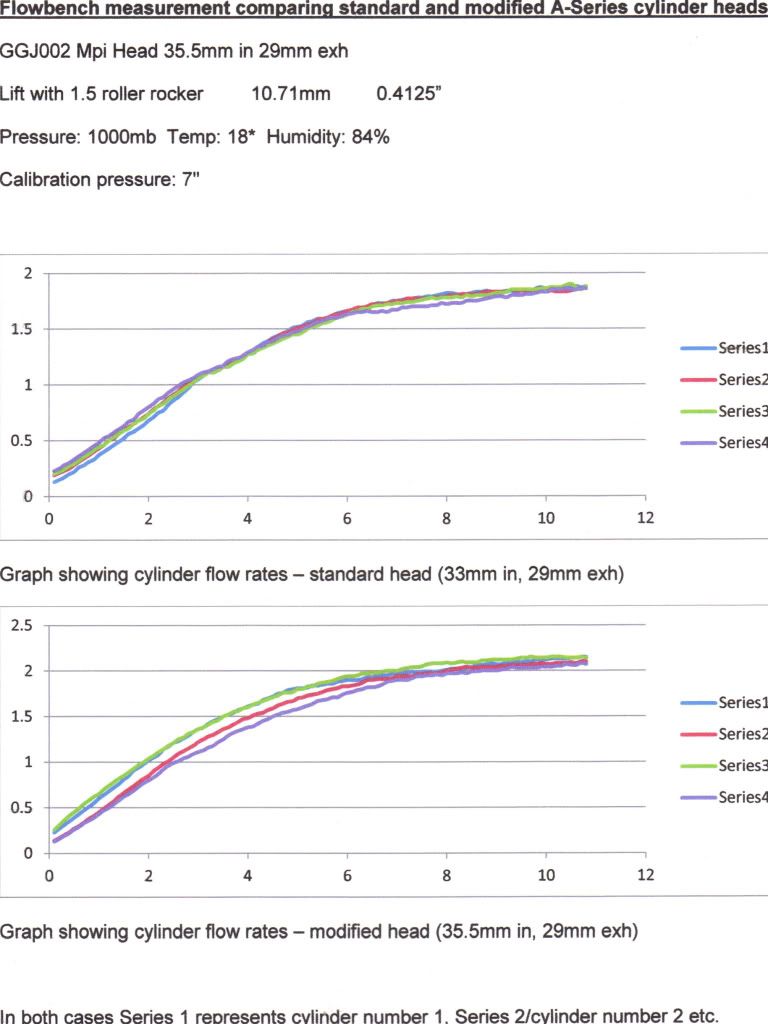Anyone know where theres a flow bench in the North East...
Discussion
Ryan,
I've made a home-made flow bench and manufactured an orifice plate (hopefully it'll show up on this photo):

In order to be able to work out how much air a head will flow, I need to know how much the orifice plate will flow. One way to do this is to put it onto a(nother) flowbench which you know the flow for and measure the plate. That's what I'd like to do.
Currently I can use the bench to flow a standard head, and can see improvements in my modded heads but can't put a flow figure to them.
I've made a home-made flow bench and manufactured an orifice plate (hopefully it'll show up on this photo):

In order to be able to work out how much air a head will flow, I need to know how much the orifice plate will flow. One way to do this is to put it onto a(nother) flowbench which you know the flow for and measure the plate. That's what I'd like to do.
Currently I can use the bench to flow a standard head, and can see improvements in my modded heads but can't put a flow figure to them.
Sorry for late reply forgot I'd responded to this lol.
How are you measuring the DP across the plate?
What I can do is calculate what the DP across the plate will be for different flows or vice versa. All I need is the overall pipe diameter and then the orifice bore diameter. If you can then give me an idea of what the pressure will be or failing that I'll just use nominal atmospheric figures of 1 bar and 15 degrees C so at those conditions assuming a density of 1kg/m3 of air. I'll be able to tell you volumetric or a mass flow. If you want to know more im happy to try to help. Might take some tinkering with but I don't mind having a bash. Let me know.
How are you measuring the DP across the plate?
What I can do is calculate what the DP across the plate will be for different flows or vice versa. All I need is the overall pipe diameter and then the orifice bore diameter. If you can then give me an idea of what the pressure will be or failing that I'll just use nominal atmospheric figures of 1 bar and 15 degrees C so at those conditions assuming a density of 1kg/m3 of air. I'll be able to tell you volumetric or a mass flow. If you want to know more im happy to try to help. Might take some tinkering with but I don't mind having a bash. Let me know.
Edited by ryandoc on Monday 19th September 23:18
Edited by ryandoc on Monday 19th September 23:21
Edited by ryandoc on Monday 19th September 23:27
Ryan, here's the bench:

I've bought a digital manometer to record the pressure difference above/below the orifice plate and have just ordered another to replace the vertical liquid manometer. I've been using 7" as the calibration pressure.
Using the pressure difference alone gave me good results, showing how much improvement I've achieved and also showing where improvements need to be made (the divider between the inlet ports on the A-series):

But I'm now thinking that it may be useful to put a flow figure to the values, also run the figures through a comparison programme to compare the results with other benches running at different pressures. What do you think?
ETA csl I'll google them.

I've bought a digital manometer to record the pressure difference above/below the orifice plate and have just ordered another to replace the vertical liquid manometer. I've been using 7" as the calibration pressure.
Using the pressure difference alone gave me good results, showing how much improvement I've achieved and also showing where improvements need to be made (the divider between the inlet ports on the A-series):

But I'm now thinking that it may be useful to put a flow figure to the values, also run the figures through a comparison programme to compare the results with other benches running at different pressures. What do you think?
ETA csl I'll google them.
Edited by Cooper1999 on Tuesday 20th September 17:53
I know nothing about flow benches for heads lol (but did google a bit).
So what also then provides the air flow just some sort of fan? I'm guessing it's not like a closed/pressurised system in that there's basically no actual pressure in the pipework before/upstream of the plate? Just an air velocity as such?
I'm not sure exactly what you mean 7" calibration pressure.
But if you can give me the diameter of the pipework that the plate is in and then the diameter of the orifice bore Nd then give me some Differential pressure values I can see what I come up with. I have no idea what the values should be so that's good in that whatever I can come up with will give us an idea if I'm in the right ball park.
As mentioned previously I'll use a pressure and temperature (atmospheric conditions 1 bar and 15 degrees C) and then a subsequent air density (1 kg/m3) and from that I can give you a volumetric and mass flow rate. What units would you prefer to see the results in cc/min or something like that?
I'll use a calculation we refer to as ISO5167 (google it it's from the ISO5167 standard for flow across a DP device) which would be overkill in this situation but will be interesting to see what comes out. It may be that the calc doesn't like such a low density but if that's the case I can simplify things and hand crank the numbers so to speak.
So what also then provides the air flow just some sort of fan? I'm guessing it's not like a closed/pressurised system in that there's basically no actual pressure in the pipework before/upstream of the plate? Just an air velocity as such?
I'm not sure exactly what you mean 7" calibration pressure.
But if you can give me the diameter of the pipework that the plate is in and then the diameter of the orifice bore Nd then give me some Differential pressure values I can see what I come up with. I have no idea what the values should be so that's good in that whatever I can come up with will give us an idea if I'm in the right ball park.
As mentioned previously I'll use a pressure and temperature (atmospheric conditions 1 bar and 15 degrees C) and then a subsequent air density (1 kg/m3) and from that I can give you a volumetric and mass flow rate. What units would you prefer to see the results in cc/min or something like that?
I'll use a calculation we refer to as ISO5167 (google it it's from the ISO5167 standard for flow across a DP device) which would be overkill in this situation but will be interesting to see what comes out. It may be that the calc doesn't like such a low density but if that's the case I can simplify things and hand crank the numbers so to speak.
Edited by ryandoc on Tuesday 20th September 18:40
I was looking at the top pic you posted (first time ive seent it on a PC today at work been viewing on a phone all the time). Have you mounted the orifice within a section of pipe like the diagram below. It's not mounted as such in that you have a pipe, then an orifice and then a void/space after the orifice is it? (so that essentially the orifice is the last thing at the end of the pipe)
I know you said you'd measured DP's so i'm guessing you've got it installed correctly, and don't take it as trying to insult your inteligence lol just thought i'd ask.
Apart from what Google told me regards flowing heads thats all I know but i'm guessing the head attaches/sits on something flat and that there's a void/space between it and where the pipework comes in so that the air flow is supplied to all the head ports at the same time?

As mentioned if you can give me the data I mentioned above we can take it from there.
I know you said you'd measured DP's so i'm guessing you've got it installed correctly, and don't take it as trying to insult your inteligence lol just thought i'd ask.
Apart from what Google told me regards flowing heads thats all I know but i'm guessing the head attaches/sits on something flat and that there's a void/space between it and where the pipework comes in so that the air flow is supplied to all the head ports at the same time?

As mentioned if you can give me the data I mentioned above we can take it from there.
Ryan, sorry for the delay in replying.
I'll get some data this week for you to work with - I've just got a second digital manometer through the post so I'll try and get some more readings this week.
Looking at the picture you posted I was trying to get a sharp edged orifice plate machined unsuccessfully. So I ended up using a hole saw (30mm being the most suitable size) and cleaned up the edges, so it's not the most precise thing!
I'll get some data this week for you to work with - I've just got a second digital manometer through the post so I'll try and get some more readings this week.
Looking at the picture you posted I was trying to get a sharp edged orifice plate machined unsuccessfully. So I ended up using a hole saw (30mm being the most suitable size) and cleaned up the edges, so it's not the most precise thing!
No probs get some figures to me I'll have a play.
As for plate sure I could put my Hands on something for you usually plenty of good condition used ones lying about at my work. Infact I scrapped about £25K worth a month ago lol. Talking 900mm wide 25mm thick made of Monel. About £9K a plate! But we use plent smaller ones as well. Might know where I can put my hands on a stainless plate 2mm think 31mm bore square edge. I'll have a look and let you know. Although we're moving office so there's a lot of stuff getting binned but I'll take a look.
As for plate sure I could put my Hands on something for you usually plenty of good condition used ones lying about at my work. Infact I scrapped about £25K worth a month ago lol. Talking 900mm wide 25mm thick made of Monel. About £9K a plate! But we use plent smaller ones as well. Might know where I can put my hands on a stainless plate 2mm think 31mm bore square edge. I'll have a look and let you know. Although we're moving office so there's a lot of stuff getting binned but I'll take a look.
Gassing Station | North East | Top of Page | What's New | My Stuff



